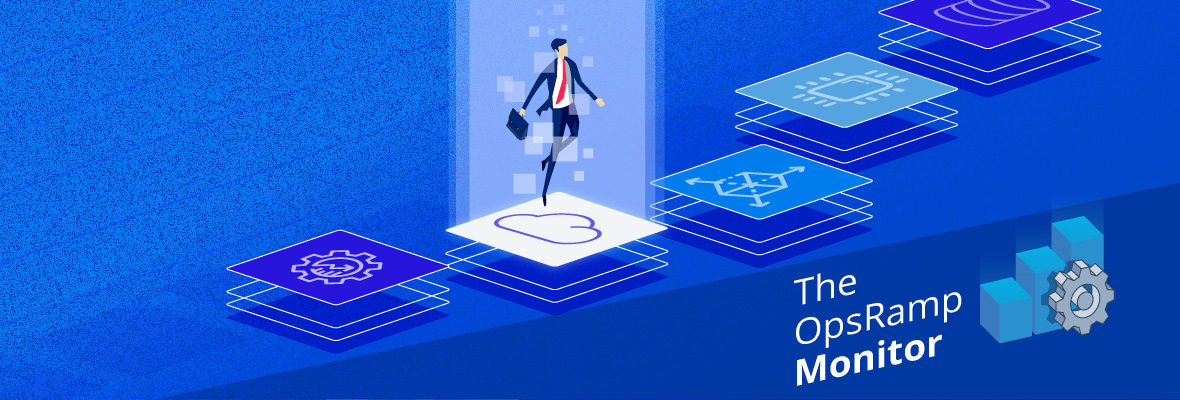Top Weekly Reads in IT I&O
The world of IT operations management, DevOps, AIOps, and cloud is always changing. That’s why there’s The OpsRamp Monitor: the occasional review of interesting developments and emerging trends in digital operations.
For IT professionals, an enduring outage is one of the worst things that can happen. There goes your credibility, and here comes the executive team enraged and impatient. Now of course, given the distributed, multi-sourced nature of IT infrastructure, some outages are simply not preventable. The details are still emerging from the June 9th outage on IBM Cloud. ITPro Today interviewed Forrester analyst Dave Bartoletti for some mitigation advice. Here’s what he said:
- Where possible, duplicate data across three regions for higher availability;
- Distribute public network-facing apps across at least two different geographic regions;
- Implement load balancing at all levels of app and database design;
- Regularly test failure scenarios.
Big Tech in hot water (again). Information is power and those who control it have weighty responsibilities. Enterprise IT leaders always need to consider this reality, but big tech powerhouses are especially in the hot seat. This TechCrunch article talked about the problem with coronavirus misinformation, reporting on the European Commission’s beef with Facebook, Google, TikTok and others: “The coronavirus pandemic has been accompanied by a massive ‘infodemic’,” commissioner Josep Borrell said at a press briefing today. “We have witnessed a wave of false and misleading information, hoaxes and conspiracy theories, as well as targeted influence operations by foreign actors.” TC reports that EU lawmakers are drafting new rules for digital services and platforms that could increase liability related to the content they host.
Cloud strategies. This is a fantastic time to be a public cloud provider, isn’t it? Survey after survey shows that CIOs are upping their investments in the public cloud because it’s become so strategic (cost-effective, scalable, flexible) during these days of massive remote work and digital business focus from Covid-19. TechRepublic reported on one recent survey which found that more than 82% of CIOs have expanded cloud usage since the onset of the pandemic. The survey, conducted by Snow Software, found that
While more than half of IT leaders expect to increase cloud spending, 31% are renegotiating their contracts and 32% are asking for extended payment terms.
This is promising: customers have options to increase cloud investments even during the worst of times. That’s also great for cloud providers and their affiliated partners/vendors who can secure customer loyalty for the long-term by being more flexible today.
Speaking of cloud options…how about some more love for Google Cloud? DataCenter Knowledge published a story about where and how GCP stands out from market leaders Azure and AWS. GCP’s hybrid cloud and multi-cloud strategy is one of the highlights, due to GCP’s platform-agnostic framework Anthos, which is built on open source technologies and therefore truly open, unlike competing services Azure Stack and AWS Outposts, which “do nothing to help customers integrate with third-party clouds.” DCK also points to GCP’s “sustained use” pricing discounts, and GCP’s access to Google’s high-performing private fiber networking infrastructure, which comes at an additional cost.
A new definition for hybrid cloud. It’s not so easy being a hybrid cloud anymore. “Gone are the days when you could plausibly claim to have a hybrid cloud simply by running some VMs in a public cloud and storing some data for them on-premises,” writes tech reporter Christopher Tozzi. To qualify as a hybrid cloud there must be tighter integration between on premise and cloud environments and “infrastructure-agnostic development and deployment techniques” using sophisticated platforms like Anthos or Azure Stack.
A new twist on chaos engineering. Failure mode and effects analysis (FMEA) is an old methodology for identifying all possible failures in a design, process, product or service. Combining FMEA with chaos engineering can improve failure detection and failure analysis, according to this blog on Gremlin. FMEA requires the analysis of Severity, Occurrence and Detection. Check out the blog for all the juicy details!
DevOps on the rise? Gene Kim, author of the IT operations manual, “The Phoenix Project,” was interviewed in Tech Central about the current state of DevOps. As with everything else, Covid-19 is creating ripples in DevOps adoption rates, he says: “I think what’s been so interesting is there are so many stories of the heroics that organisations have to do to enable tens of thousands, hundreds of thousands of workers to be able to work from home. That was only possible by essentially breaking all the rules.” And while some sectors have been affected more than others in the pandemic, Kim says that Covid-19 will push every industry to adopt DevOps faster. Business survival during highly volatile times requires rapid adaptation. [Read up on WWII economic measures for an apt analogy to current times.]
How to make more money or be happier in IT. Wait a minute, what if you could do both? Start by looking into this cloud engineering boot camp, sponsored by the Linux Foundation and detailed in this article. Cloud engineers are some of the highest paid people in IT, with median salaries of $146,000. Plus people love you because you’re wicked smart. If you’re a CIO you’re most likely already making more than that but it’s taken you eons to get to where you are. Do you want to keep doing your job? Then you better think about being a true business leader, says CIO.com. That means expanding responsibilities beyond traditional IT (such as supply chain, e-commerce) and leading revenue-generating projects. The article cites some research as to how CIOs can evolve: “To support these efforts, CIOs are creating teams focused on innovation (46%), establishing business-case scenarios with defined costs and benefits (46%), and interacting more directly with customers (42%).” It sounds like a lot of pressure to add even more to the CIO job, yet doing so could make for a more meaningful career and that means happiness. Right?
In closing, let’s touch on diversity. The research continues to show the positive influence of having a diverse workforce. CIO Dive reported on the results of a study of more than 201 tech companies, based on EEO data.
Researchers found that a 1% increase in racial diversity in management increased a tech firm's productivity by $729 per employee and at Fortune 500 firms, by $1,590 per employee.
Diversity at the very top is also tied to better results. Companies with more racial diversity in upper management out-produced firms with more diversity in lower management.






